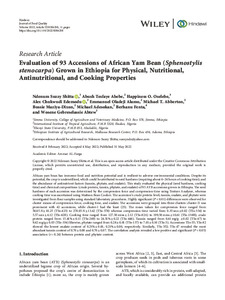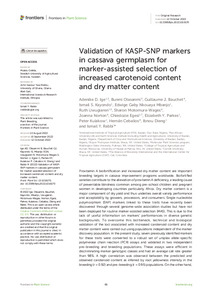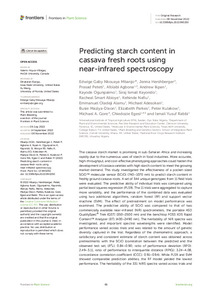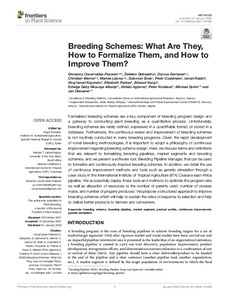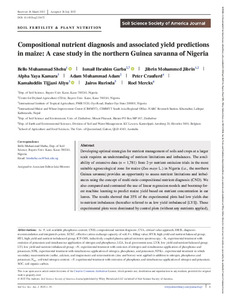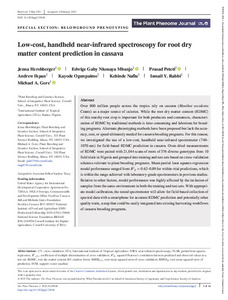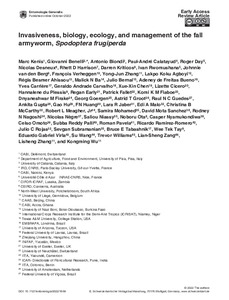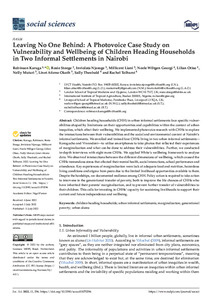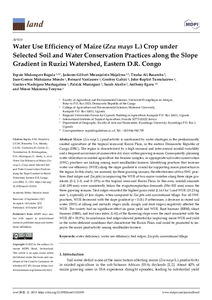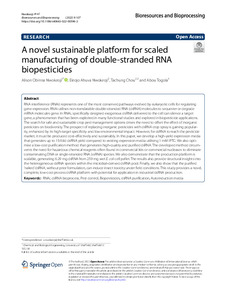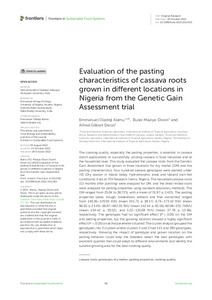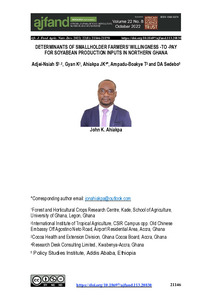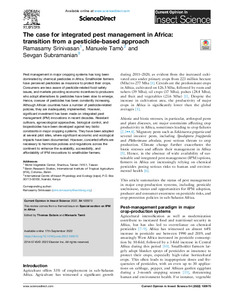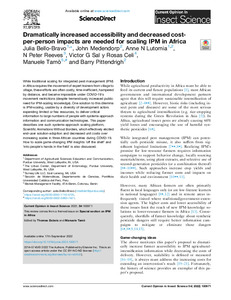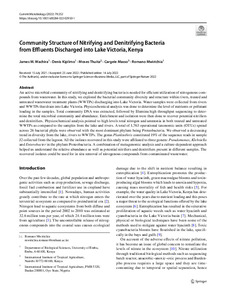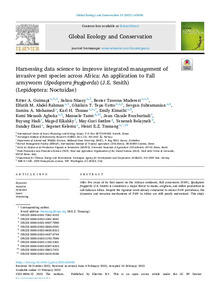Welcome to the International Institute of Tropical Agriculture Research Repository
Journal and Journal Articles: Recent submissions
Now showing items 481-500 of 5286
-
Evaluation of 93 accessions of African yam bean (Sphenostylis stenocarpa) grown in Ethiopia for physical, nutritional, antinutritional, and cooking properties
(2022)African yam bean has immense food and nutrition potential and is resilient to adverse environmental conditions. Despite its potential, the crop is underutilized, which could be attributed to seed hardness (requiring about 6–24 hours of cooking time); and the abundance of antinutrient factors (tannin, phytate, and oxalate). This study evaluated the physical (seed hardness, cooking time) and chemical compositions (crude protein, tannin, phytate, and oxalate) of 93 AYB accessions grown in Ethiopia. ... -
Tolerance to soil acidity of soybean (Glycine max L.) genotypes under field conditions Southwestern Ethiopia
(2022)Soil acidity with associated low nutrient availability is one of the major constraints to soybean production in southwestern Ethiopia. Integrated use of lime and acid-tolerant crops is believed to reduce soil acidity and improve crop production. The experiment was conducted in the field condition of Mettu, southwestern Ethiopia during the 2017/18 main cropping season. The experiment comprised fifteen soybean genotypes and two soil amendment (lime and unlimed) treatments arranged in a split-plot ... -
Validation of KASP-SNP markers in cassava germplasm for marker-assisted selection of increased carotenoid content and dry matter content
(2022)Provitamin A biofortification and increased dry matter content are important breeding targets in cassava improvement programs worldwide. Biofortified varieties contribute to the alleviation of provitamin A deficiency, a leading cause of preventable blindness common among pre-school children and pregnant women in developing countries particularly Africa. Dry matter content is a major component of dry yield and thus underlies overall variety performance and acceptability by growers, processors, and ... -
Predicting starch content in cassava fresh roots using near-infrared spectroscopy
(2022)The cassava starch market is promising in sub-Saharan Africa and increasing rapidly due to the numerous uses of starch in food industries. More accurate, high-throughput, and cost-effective phenotyping approaches could hasten the development of cassava varieties with high starch content to meet the growing market demand. This study investigated the effectiveness of a pocket-sized SCiO™ molecular sensor (SCiO) (740−1070 nm) to predict starch content in freshly ground cassava roots. A set of 344 ... -
Breeding schemes: what are they, how to formalize them, and how to improve them?
(2022)Formalized breeding schemes are a key component of breeding program design and a gateway to conducting plant breeding as a quantitative process. Unfortunately, breeding schemes are rarely defined, expressed in a quantifiable format, or stored in a database. Furthermore, the continuous review and improvement of breeding schemes is not routinely conducted in many breeding programs. Given the rapid development of novel breeding methodologies, it is important to adopt a philosophy of continuous ... -
Compositional nutrient diagnosis (CND) and associated yield predictions in maize: a case study in the northern Guinea savanna of Nigeria
(2022)Developing optimal strategies for nutrient management of soils and crops at a larger scale requires an understanding of nutrient limitations and imbalances. The availability of extensive data (n = 1,781) from 2-yr nutrient omission trials in the most suitable agroecological zone for maize (Zea mays L.) in Nigeria (i.e., the northern Guinea savanna) provides an opportunity to assess nutrient limitations and imbalances using the concept of multi-ratio compositional nutrient diagnosis (CND). We also ... -
Low-cost, handheld near-infrared spectroscopy for root dry matter content prediction in cassava
(2022)Over 800 million people across the tropics rely on cassava (Manihot esculenta Crantz) as a major source of calories. While the root dry matter content (RDMC) of this starchy root crop is important for both producers and consumers, characterization of RDMC by traditional methods is time-consuming and laborious for breeding programs. Alternate phenotyping methods have been proposed but lack the accuracy, cost, or speed ultimately needed for cassava breeding programs. For this reason, we investigated ... -
Invasiveness, biology, ecology, and management of the fall armyworm, Spodoptera frugiperda
(2022)The fall armyworm (FAW), Spodoptera frugiperda (JE Smith, 1797), is a serious pest of several crops, particularly maize and other cereals. It has long been known as a pest in the Americas and has invaded most of Africa and parts of the Middle East, Asia, and Australia in the last six years. Its new status as an invasive species causing serious damage in many regions worldwide has highlighted the need for better understanding and has generated much research. In this article, we provide a comprehensive ... -
Mitigating aflatoxin in Rwanda
(2021)On August 18th, 2021, the International Growth Centre and the Rwandan Ministry of Agriculture organised a webinar under the theme Market Driven Strategies for Mitigating Aflatoxin in Rwanda. The webinar highlighted Rwanda's progress towards mitigating aflatoxin and showcased innovative approaches used by neighbouring countries. The event was an opportunity for stakeholders to discuss Rwanda’s key challenges in post-harvest management and assess the evidence on approaches that have (not) worked in ... -
Plantain hybrids for the humid forest agroecology of Central Africa – diseases and pests load, fruit yield and farmers perception
(2022)Plantain is one of the major staples contributing to food security and income generation in West and Central Africa. Local cultivars in Cameroon are susceptible to pests and diseases causing severe losses in plantain production. This study aimed at evaluating the agronomic performance and producer’s perception of plantain hybrids in the humid forest of Cameroon. Field trials were established in a completely randomized block design with eight genotypes and three replicates. Data on pest and disease ... -
Leaving no one behind: a photovoice case study on vulnerability and wellbeing of children heading households in two informal settlements in Nairobi
(2022)Children heading households (CHH) in urban informal settlements face specific vulnerabilities shaped by limitations on their opportunities and capabilities within the context of urban inequities, which affect their wellbeing. We implemented photovoice research with CHHs to explore the intersections between their vulnerabilities and the social and environmental context of Nairobi’s informal settlements. We enrolled and trained four CHHs living in two urban informal settlements—Korogocho and ... -
Water use efficiency of maize (Zea mays L.) crop under selected soil and water conservation practices along the slope gradient in Ruzizi watershed, eastern D.R. Congo
(2022)Maize (Zea mays L.) productivity is constrained by water shortages in the predominantly rainfed agriculture of the tropical semi-arid Ruzizi Plain, in the eastern Democratic Republic of Congo (DRC). The region is characterized by a high seasonal and inter-annual rainfall variability and a frequent occurrence of consecutive dry days within growing seasons. Consequently, planning water utilization in rainfed agriculture has become complex, as appropriate soil water conservation (SWC) practices are ... -
A novel sustainable platform for scaled manufacturing of double‑stranded RNA biopesticides
(2022)RNA interference (RNAi) represents one of the most conserved pathways evolved by eukaryotic cells for regulating gene expression. RNAi utilises non-translatable double-stranded RNA (dsRNA) molecules to sequester or degrade mRNA molecules gene. In RNAi, specifically designed exogenous dsRNA delivered to the cell can silence a target gene, a phenomenon that has been exploited in many functional studies and explored in biopesticide applications. The search for safe and sustainable crop pest management ... -
Evaluation of the pasting characteristics of cassava roots grown in different locations in Nigeria from the Genetic Gain Assessment trial
(2022)The cooking quality, especially the pasting properties, is essential in cassava starch applications or successfully utilizing cassava in food industries and at the household level. This study evaluated the cassava roots from the Genetic Gain Assessment trial grown in three locations for dry matter (DM) and the pasting characteristics. Four hundred cassava genotypes were planted under IVS (Dry season in Inland Valley Hydromorphic area) and Upland (rain-fed conditions) trials at IITA Research Farms, ... -
How does IPM 3.0 look like (and why do we need it in Africa)?
(2022-10)The concept of Integrated Pest Management (IPM) was introduced sixty years ago to curb the overuse of agricultural pesticides, whereby its simplest version (IPM 1.0) was aiming at reducing the frequency of applications. Gradually, agro-ecological principles, such as biological control and habitat management, were included in IPM 2.0. However, throughout this time, smallholder farmers did not improve their decision-making skills and continue to use hazardous pesticides as their first control option. ... -
Determinants of smallholder farmers' willingness-to-pay for soyabean production inputs in northern Ghana
(2022-10)Farmers in northern Ghana have been cultivating soyabean with very little or no agro-inputs due to cost and limited accessibility. Use of quality agro-inputs can significantly improve the productivity of soyabean. This study assesses farmers’ current use of soyabean production agro-inputs, identifies challenges faced by smallholder farmers in soyabean cultivation and assesses factors influencing farmers’ willingness-to-pay (WTP) for soyabean inputs (determinants) in northern Ghana. Four hundred ... -
The case for integrated pest management in Africa: transition from a pesticide-based approach
(2022-12)Pest management in major cropping systems has long been dominated by chemical pesticides in Africa. Smallholder farmers have perceived pesticides as insurance to protect their crops. Consumers are less aware of pesticide-related food-safety issues, and markets providing economic incentives to producers who adopt alternatives to pesticides have been slow to emerge. Hence, overuse of pesticides has been constantly increasing. Although African countries have a number of pesticide-related policies, ... -
Dramatically increased accessibility and decreased cost- per-person impacts are needed for scaling IPM in Africa
(2022-12)While traditional scaling for integrated pest management (IPM) in Africa requires the movement of expert trainers from village to village, these efforts are often costly, time-inefficient, hampered by distance, and became impossible under COVID-19's movement restrictions (despite tremendously increased public need for IPM-scaling knowledge). One solution to this dilemma is IPM-scaling, usable by a diversity of development actors expending limited or few resources, to deliver critical information ... -
Community structure of nitrifying and denitrifying bacteria from effluents discharged into Lake Victoria, Kenya
(2022)An active microbial community of nitrifying and denitrifying bacteria is needed for efficient utilization of nitrogenous compounds from wastewater. In this study, we explored the bacterial community diversity and structure within rivers, treated and untreated wastewater treatment plants (WWTPs) discharging into Lake Victoria. Water samples were collected from rivers and WWTPs that drain into Lake Victoria. Physicochemical analysis was done to determine the level of nutrients or pollutant loading ... -
Harnessing data science to improve integrated management of invasive pest species across Africa: An application to Fall armyworm (Spodoptera frugiperda) (J.E. Smith) (Lepidoptera: Noctuidae)
(2022-06)After five years of its first report on the African continent, Fall armyworm (FAW), Spodoptera frugiperda (J.E. Smith) is considered a major threat to maize, sorghum, and millet production in sub-Saharan Africa. Despite the rigorous work already conducted to reduce FAW prevalence, the dynamics and invasion mechanisms of FAW in Africa are still poorly understood. This study applied interdisciplinary tools, analytics, and algorithms on a FAW dataset with a spatial lens to provide insights and project ...

